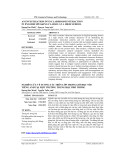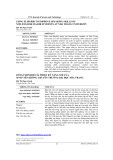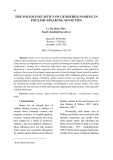
Quy Nhon University Journal of Science, 2024, 18(6), 59-75 63
https://doi.org/10.52111/qnjs.2024.18605
QUY NHON UNIVERSITY
SCIENCE
JOURNAL OF
toward learning the target language.18 Language
teachers can help their students enhance their
self-motivation by attracting their attention to
practical strategies like “favorable expectations,
incentives, dealing with procrastination and
boredom, and eliminating distractions”.18 A
positive and nurturing learning environment
plays a crucial role in fostering students' interest
and motivation. Therefore, the role of the teacher
extends beyond imparting knowledge; they also
serve as motivators, encouragers, and creators of
a positive learning atmosphere to help students
develop their speaking skills confidently and
effectively.
2.1.3.3. Factors related to facilities
To achieve quality education in English as a
foreign language, the learning environment and
facilities are essential variables.19 School facilities
affect learning. Longitudinal configurations,
noise, heat, cold, light, and air quality bear on
students’ and teachers’ ability to perform.20
Teachers play an undeniable role in leveraging
facilities to construct a positive and effective
learning environment. They impart knowledge
and encourage students to utilize available
resources for self-improvement. Language is
best learned through the use of learning facilities
and communication among students. This type
of collaboration results in benefits for all or both
learners.21
2.1.3.4. Factors related to teaching materials
Teaching and learning materials directly affect
students’ learning achievements.22 Teaching
materials play a crucial role in influencing
students' loss of interest in developing speaking
skills. When materials are not designed to
be engaging and interesting, students may
lose motivation and fail to find enthusiasm
to participate in the learning process. These
materials include textbooks, workbooks, writing
paper, pens/pencils, chalk, blackboards, wall
pictures, tapes, tape recorders, television,
radio, reading material, and a library. All those
materials affect students’ attitudes toward
English learning.22-25
The use of rich and realistic teaching
materials is significant. Teachers need to select
materials that align with students' proficiency
levels and needs. Moreover, they should create
engaging and positive activities to stimulate
students' interest and participation in the process
of learning speaking skills.
2.1.3.5. Factors related to classroom climate
A socially active and productive classroom
climate is marked by students interacting in
supportive and sympathetic interactions with
peers.26,27 Creating an ideal classroom climate
is a key factor in developing students' English-
speaking skills. A positive classroom climate
for the best forms of learning to occur is marked
by teachers trying to establish effective positive
interactions in the environment of the class.28
The necessity of such a favorable climate lies in
the fact that when language teachers and students
interact in a positive atmosphere, they can have
better concentration, feel calmer, achieve better
educational goals, and work to their best.27
2.1.3.6. Factors related to speaking practice
opportunities
Throughout the learning process, having
opportunities to practice speaking helps learners
become more confident in language usage. These
opportunities may include engaging in dialogues,
participating in group discussions, performing
communicative tasks, and joining language-
oriented activities. Likewise, Yuliandasari
and Kusriandi believe that participating in an
English club is also an opportunity for students
to practice speaking regularly.29 Additionally,
utilizing technology, such as online English
learning applications and chat forums, also
opens up numerous new avenues for flexible and
effective speaking practice. For the development
of communication skills, creating and leveraging
speaking practice opportunities is undeniable.
2.2. Previous studies
Research on students' English speaking
difficulties is not the first. Before this research,
there were many types of research that studied































